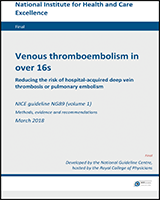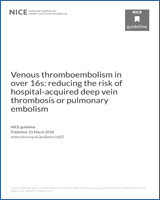NCBI Bookshelf. A service of the National Library of Medicine, National Institutes of Health.
National Guideline Centre (UK). Venous thromboembolism in over 16s: Reducing the risk of hospital-acquired deep vein thrombosis or pulmonary embolism. London: National Institute for Health and Care Excellence (NICE); 2018 Mar. (NICE Guideline, No. 89.)
December 2019: In recommendation 1.3.5 the British Standards for anti-embolism hosiery were updated because BS 6612 and BS 7672 have been withdrawn. August 2019: Recommendation 1.12.11 (1.5.30 in this document) was amended to clarify when anti-embolism stockings can be used for VTE prophylaxis for people with spinal injury.

Venous thromboembolism in over 16s: Reducing the risk of hospital-acquired deep vein thrombosis or pulmonary embolism.
Show details20.1. Introduction
Patients admitted to a critical care facility (who are generally in need of level 2 or level 3 care) can be separated into some distinct groups by their disease process:
- patients with any acute illness that has resulted in one or more organ systems failing and have a need for interventions to support organ function
- patients who need a higher level of observation and intervention that cannot safely be provided elsewhere
- patients who have had complex or prolonged surgical procedures and hence require a duration of recovery with a higher level of observation and monitoring than can be provided elsewhere in order to rapidly detect and mange any deterioration
- patients who are dying and there is ongoing consideration of organ donation.
Each group has its own unique risk factors for VTE and risks of bleeding or other complications. The unifying feature is that during times of severe physiological upset, the inflammatory response is at a maximum and the patient is almost always immobile and likely to have a number of intravascular catheter devices. This puts the patient at a much higher risk of developing venous thrombi. The same patient may however also be at an increased risk of bleeding, either due to a coagulopathy as a consequence of their disease or interventions; or be at risk of bleeding into a surgical field with disastrous consequences such as in spinal surgery or neurosurgery. The medications and equipment used in critical care may increase the risk of bleeding further.
Critically ill patients will have a number of such risk factors which may change in nature, number and significance many times throughout their stay. Also, many invasive procedures may be carried out during such an admission (central lines, lumbar punctures, chest drains etc) and so relative risks of bleeding as a consequence will also change many times.
20.2. Review question: What is the effectiveness of different pharmacological and mechanical prophylaxis strategies (alone or in combination) for people admitted to critical care units?
For full details see review protocol in appendix C.
Table 117
PICO characteristics of review question.
20.3. Clinical evidence
One study which compared the effectiveness of different prophylaxis treatments for people admitted to critical care units was included in the previous guideline (CG92) 54. However, this study was excluded from the update because the inclusion criteria reported in the study was not appropriate for this review. Patients included in this study previously had a DVT event or presence of signs of a DVT at inclusion.
A search was conducted for randomised trials comparing the effectiveness of different pharmacological and mechanical prophylaxis strategies (alone or in combination) for people admitted to the critical care units. Two randomised controlled trials were included 39 192 these are summarised in Table 118 below. Evidence from these studies is summarised in the clinical evidence summary tables below (Table 119 and Table 120). See also the study selection flow chart in appendix E, forest plots in appendix L, study evidence tables in appendix H, GRADE tables in appendix K and excluded studies list in appendix N.
Table 118
Summary of studies included in the review.
20.3.1. LMWH (standard dose; standard duration) versus UFH in people admitted to ICUs
Table 119
Clinical evidence summary: LMWH (standard dose; standard duration) versus UFH.
20.3.2. People who are contraindicated to pharmacological prophylaxis
Table 120
Clinical evidence summary: IPCD (half-leg) and AES versus AES.
20.4. Economic evidence
Published literature
No relevant health economic studies were identified.
See also the health economic study selection flow chart in appendix F.
20.5. Evidence statements
Clinical
LMWH at a standard dose for a standard duration was compared with UFH, the outcomes all-cause mortality, DVT (symptomatic and asymptomatic), PE, major bleeding and heparin-induced thrombocytopenia were reported in one study. There was clinical benefit of LMWH in terms of all-cause mortality, possible clinical benefit of LMWH in terms of PE and heparin-induced thrombocytopenia, although all these findings could also be consistent with no difference. There was no clinical difference in terms of DVT (symptomatic and asymptomatic) and major bleeding, however there was some uncertainty around these results. The quality of the evidence ranged from very low to moderate due to risk of bias, indirectness and imprecision.
People who are contraindicated to pharmacological prophylaxis
IPCD (half-leg) in combination with AES was compared with AES, the outcomes DVT (symptomatic and asymptomatic), PE and fatal PE were reported in one study. There was possible clinical benefit of IPCD in combination with AES in terms of DVT (symptomatic and asymptomatic) and PE. However the uncertainty around these results means they are also consistent with no difference or clinical harm. There was no clinical difference in terms of fatal PE. The quality of the evidence was very low due to risk of bias, indirectness and imprecision.
Economic
No relevant economic evaluations were identified.
20.6. Recommendations and link to evidence
| Recommendations |
|
| Research recommendation | None |
| Relative values of different outcomes |
The committee considered all-cause mortality (up to 90 days after leaving ICU), deep vein thrombosis (symptomatic and asymptomatic) (7–90 days after leaving ICU), pulmonary embolism (7–90 days after leaving ICU), major bleeding (up to 45 days after leaving ICU) and fatal PE (7–90 days after leaving ICU) as critical outcomes. The committee considered clinically relevant non-major bleeding (up to 45 days after leaving ICU), health-related quality of life (up to 90 days after leaving ICU), heparin-induced thrombocytopenia (duration of study), technical complications of mechanical interventions (duration of study) and line associated thrombosis (duration of study) as important outcomes. Please see section 4.4.3 in the methods chapter for further detail on prioritisation of the critical outcomes. |
| Quality of the clinical evidence |
Two randomised controlled trials were included in this review. One of these studies evaluated the use of LMWH (dalteparin) versus unfractionated heparin (UFH) for people admitted to critical care units. The quality of the evidence ranged from very low to moderate. Evidence was downgraded due to risk of bias, indirectness and imprecision. Outcomes were downgraded for indirectness due to an inappropriate time point, past the time-point set by the committee (up to 90 days after leaving ICU). The other included study evaluated the use of IPCD with AES versus AES alone. The quality of the evidence ranged from very low to low due to risk of bias, indirectness and imprecision. |
| Trade-off between clinical benefits and harms |
This is a critically ill population where survival is the most immediate concern. Patients may be admitted into critical care from different wards within the hospital, representing a worsening of the person’s condition. Therefore it is important to reassess the person’s risk on admission to ICU as risk may differ from first assessment and the clinical condition may have changed. Critical care is a recognised risk factor for increasing VTE risk (it is a factor in both the Department of Health risk assessment list and risk tools such as the 7-factor version of IMPROVE) and as such the committee considered that in absence of bleeding risk factors and after taking into account planned interventions or therapies which may increase complications, VTE prophylaxis should be offered. Moderate quality evidence showed a clinically important difference in mortality rate in those offered LMWH compared to those offered UFH. No evidence was identified for any other pharmacological intervention. Therefore the committee felt comfortable recommending LMWH for this population. The committee noted that renal impairment is a concern within this population and advise clinicians to refer to the renal impairment recommendation when applicable. Due to the high VTE risk in this population, if people were contraindicated for pharmacological prophylaxis, the committee recommended considering mechanical prophylaxis. As the clinical situation changes it is necessary to reassess the risks of VTE and bleeding. For this reason the committee did not state a recommended duration for LMWH as they considered it would be up to clinical judgement based on the daily reassessment of changing VTE and bleeding risk. |
| Trade-off between net clinical effects and costs |
No economic studies were included for this population. Unit costs of pharmacological and mechanical prophylaxis were presented to the committee (see appendix Q). The committee acknowledged that there will be a cost impact given the need for more staff time to complete the assessment on admission to the critical care unit, but this will be off-set by the potential benefits for reducing the risk of having a costly VTE event. The committee noted that the clinical evidence showed a clinical benefit for LMWH versus UFH in terms of PE, heparin-induced thrombocytopenia and mortality and considered that the higher cost of using LMWH would be offset by the downstream cost saving from averted PEs and HIT. For people in whom pharmacological options are contraindicated, the committee considered that the evidence available supported the use of mechanical prophylaxis given the high risk of VTE in this population. |
| Other considerations | Patients treated in the critical care unit may be unconscious or not capable of making decisions about their treatment. In such situations, decisions about care should take into account the known view of patients and discussions with family members, where appropriate. |
Footnotes
- bbbb
At the time of publication (March 2018), LMWH did not have a UK marketing authorisation for use in young people under 18 for this indication. The prescriber should follow relevant professional guidance, taking full responsibility for the decision. Informed consent should be obtained and documented. See the General Medical Council’s Prescribing guidance: prescribing unlicensed medicines for further information.
- People admitted to critical care units - Venous thromboembolism in over 16sPeople admitted to critical care units - Venous thromboembolism in over 16s
Your browsing activity is empty.
Activity recording is turned off.
See more...
